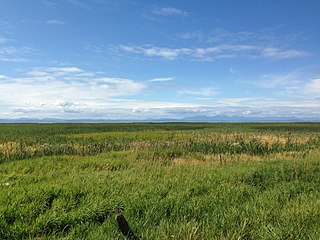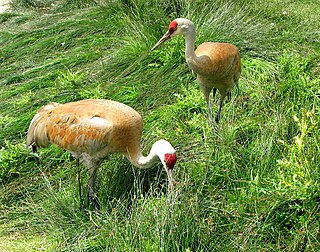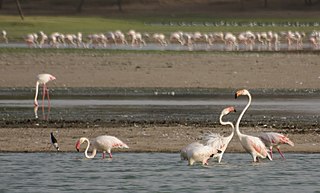
National Chambal Sanctuary, also called the National Chambal Gharial Wildlife Sanctuary, is a 5,400 km2 (2,100 sq mi) tri-state protected area in northern India for the protection of the Critically Endangered gharial, the red-crowned roof turtle and the Endangered Ganges river dolphin. Located on the Chambal River near the tripoint of Rajasthan, Madhya Pradesh and Uttar Pradesh, it was first declared in Madhya Pradesh in 1978, and now constitutes a long narrow eco-reserve co-administered by the three states. Within the sanctuary, the pristine Chambal River cuts through mazes of ravines and hills with many sandy beaches.

Sultanpur National Park (formerly Sultanpur Bird Sanctuary) is located at Sultanpur village on Gurugram-Jhajjar highway, 15 km from Gurugram, Haryana and 50 km from Delhi in India. This covers approximately 142.52 hectares.

Nal Sarovar Bird Sanctuary, consisting primarily of a 120.82-square-kilometre (46.65 sq mi) lake and ambient marshes, is situated about 64 km to the west of Ahmedabad near Sanand Village, in the Indian state of Gujarat. Mainly inhabited by migratory birds in winter and spring, it is the largest wetland bird sanctuary in Gujarat, and one of the largest in India. It was declared a bird sanctuary in April 1969.
The Rann of Kutch Wildlife Sanctuary is the largest Ramsar site in Sindh, covering 566,375 ha, and is located in the Rann of Kutch in Badin District, Sindh, Pakistan. It was declared a wildlife sanctuary by the government of Sindh in 1980.

Nawabganj Bird Sanctuary, renamed in 2015 Shahid Chandra Shekhar Azad Bird Sanctuary, is a bird sanctuary located in Unnao district on the Kanpur-Lucknow highway in Uttar Pradesh, India consisting of a lake and the surrounding environment. It is one of the many wetlands of Northern India. The sanctuary provides protection for 250 species of migratory birds mostly from CIS countries, but the numbers have been dwindling since the 1990s, most having relocated to newer areas in Himachal and Rajasthan. The sanctuary also houses a deer park, watchtowers and boats.

The Alaksen National Wildlife Area is located on Westham Island in the city of Delta, British Columbia. It is an important stopover point for many species of birds migrating along the Pacific Flyway.
Saman Bird Sanctuary is a wetland in Mainpuri district, in western Uttar Pradesh. Located in the village of Saman, it has been designated as a protected Ramsar site since 2019.

Harike Wetland also known as "Hari-ke-Pattan", with the Harike Lake in the deeper part of it, is the largest wetland in northern India in the border of Tarn Taran Sahib district and Ferozepur district of the Punjab state in India.

The Central Asian Flyway (CAF), Central Asian-Indian Flyway, or Central Asian-South Asian Flyway is a flyway covering a large continental area of Eurasia between the Arctic Ocean and the Indian Ocean and the associated island chains. The CAF comprises several important migration routes of waterbirds, most of which extend from the northernmost breeding grounds in Siberia to the southernmost non-breeding wintering grounds in West Asia, India, the Maldives and the British Indian Ocean Territory.
The San Luis National Wildlife Refuge Complex is located in the northern San Joaquin Valley, within Merced County and Stanislaus County of California. The complex, with four federal National Wildlife Refuges, is managed by the U.S Fish & Wildlife Service.

George C. Reifel Migratory Bird Sanctuary is a protected area in Delta, British Columbia, Canada, and is part of the Fraser River estuary, designated a site of Hemispheric Importance by the Western Hemisphere Shorebird Reserve Network.
The Chari-Dhand wetland conservation reserve is located on the edge of arid Banni grasslands and the marshy salt flats of the Rann of Kutch in Kutch district, Gujarat State in India. It is currently legally protected under the status as a Protected or Reserve Forest in India. Chari means salt affected and Dhand means shallow wetland, Dhand is a Sindhi word for a shallow saucer shaped depression. This is a seasonal desert wetland and only gets swampy during a good monsoon, receiving water from the north flowing rivers as well as from the huge catchment areas of many surrounding big hills. It is spread over an area of 80 km2. It is in Nakhtrana Taluka, 80 km south west to the city of Bhuj, about 7 or 8 km from Fulary village and 30 km from Nakhtrana town. It is home to nearly two lakh birds with migratory and endangered species of birds flocking into the area in thousands during monsoon and winters.

The Kanwar Taal or Kabar Taal Lake or Kabartal Wetland located in Begusarai district of Bihar, India, is Asia's largest freshwater oxbow lake. It is approximately six times the size of the Bharatpur Sanctuary. In November 2020, the Ministry of Environment, Forest and Climate Change (MoEFCC) declared it the first Ramsar site in Bihar. There are a total of 80 Ramsar Sites in India till 2024.
Kanwar jheel, as it is locally called, is located 22 km north-west of Begusarai Town in Manjhaul. It is a residual oxbow lake, formed due to meandering of Burhi Gandak river, a tributary of Ganga, in the geological past. It covers 2,620 hectares of the Indo-Gangetic plains in the northern Bihar State. The Site is one of 18 wetlands within an extensive floodplain complex; it floods during the monsoon season to a depth of 1.5 metres. This absorption of floodwaters is a vital service in Bihar State where 70% of the land is vulnerable to inundation. During the dry season, areas of marshland dry out and are used for agriculture. Significant biodiversity is present, with 165 plant species and 394 animal species recorded, including 221 bird species. The Wetland is an important stopover along the Central Asian Flyway, with 58 migratory waterbirds using it to rest and refuel. It is also a valuable site for fish biodiversity with over 50 species documented. Five critically endangered species inhabit the site, including three vultures – the red-headed vulture, white-rumped vulture and Indian vulture – and two waterbirds, the sociable lapwing and Baer’s pochard. Major threats to the Site include water management activities such as drainage, water abstraction, damming and canalization.

Thol Lake is an artificial lake near Thol village in Kadi in Mehsana District in the Indian state of Gujarat. A fresh water lake surrounded by marshes, it was built as an irrigation tank in 1912. Declared the Thol Bird Sanctuary in 1988, it is a habitat to 150 species of birds, about 60% of them waterbirds. Many migratory birds nest and breed in the lake and its periphery. The two most prominent species of birds recorded in the sanctuary are flamingoes and sarus crane. The sanctuary is also proposed to be declared an Eco-Sensitive Zone, conforming to the Environment (Protection) Act, 1986, for which draft notification has been prepared.

Khijadiya Bird Sanctuary is a bird sanctuary located in Jamnagar district of Gujarat, India. About 300 species of migratory birds have been recorded here.

Vadayil Sankaran Vijayan is an Indian environmentalist, wildlife biologist, ornithologist, an admirer of naturopathy and the founding Director of the Salim Ali Centre for Ornithology and Natural History. He is currently the chairman of the Salim Ali Foundation.
Last Mountain Lake Bird Sanctuary is a National Historic Site of Canada, located in the rural municipality of Last Mountain Valley No. 250 in Saskatchewan. The migratory bird sanctuary was the first established in North America. The 47.36 km2 (18.29 sq mi) area is within the Last Mountain Lake National Wildlife Area, an International Biological Program site, and includes adjacent uplands.

The Karaivetti Bird Sanctuary is a 4.537-square-kilometre (1.752 sq mi) protected area and Ramsar site, located in the Ariyalur District of the state of Tamil Nadu, India. The sanctuary is about 25 kilometres (16 mi) from Thanjavur. This freshwater lake is fed by Pullambadi, Kattalal canal and attracts thousands of birds every year. This lake was declared as a sanctuary in 1999 by the Government of Tamil Nadu and in 2024, it became a Ramsar site. About 200 birds are species recorded from this sanctuary. Karaivetti Bird Sanctuary is one of the Important Bird Areas (IBA's) of Tamil Nadu.

Bandh Baretha is a freshwater man-made wetland and wildlife sanctuary covering an area of 10 square kilometers. It is located approximately 50 kilometers south of Bharatpur city, in the Bayana tehsil of Bharatpur, India. This sanctuary serves as a significant winter resort for migratory birds and plays a crucial role in storing drinking water for the region.
Panchana Dam is a freshwater man-made wetland located in Gudla village, Krauli district, Rajasthan, approximately 100 km southeast of Bharatpur. Positioned upstream of the Gambhir River at Krauli, water from this river is crucial for reaching Keoladeo National Park by September. Failure to release water could impact migratory bird visits to the park. The dam stores water from five rivers, supplying Krauli, Sawai Madhopur, and Bharatpur.


























